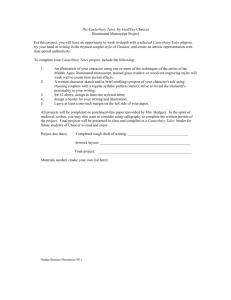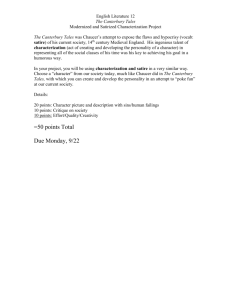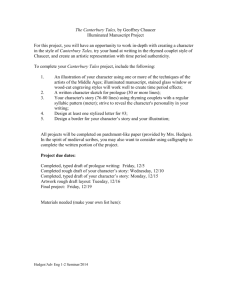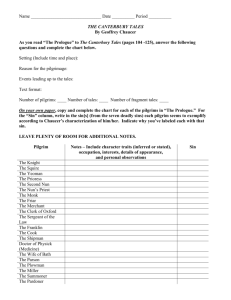Geoffrey Chaucer
advertisement
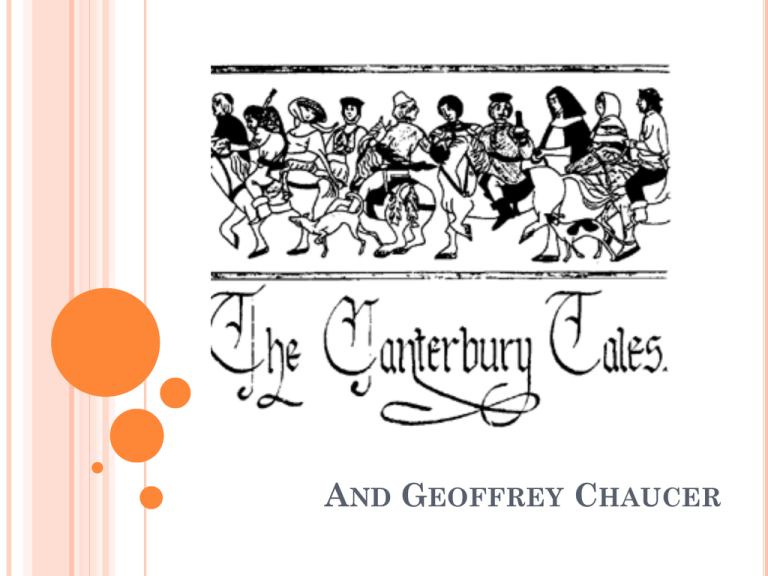
AND GEOFFREY CHAUCER BIRTH AND EARLY LIFE Born in 1340 in London to John Chaucer, a vitner (wine merchant). He would have been upper middle class. 1357 – worked as a page in the household of Prince Lionel 1359- served in army. Captured by the French but ransomed by the king. ADULT LIFE 1366 married Phillippa Roet, a lady-in-waiting to the queen. 1370-1378 sent on diplomatic missions to France and Italy. 1386 – began having financial problems 1387 on – Worked on The Canterbury Tales October 25, 1400 – Chaucer died. Buried in Westminster. NEED TO KNOW Pilgrimage – a religious journey Thomas a Becket – Catholic martyr, former Archbishop of Canterbury(1162-1170). The pilgrims are travelling to his tomb. His shrine was reputed to have great healing qualities. THE CANTERBURY TALES – THE PLAN First collection of short stories in English About a group of pilgrims travelling to Canterbury the seat of the English church (which was still Catholic) who agree to tell stories to pass the time. Language – Middle English (combination of Old English (Anglo-Saxons) and Norman French Frame story (story within a story) Each pilgrim was supposed to tell two tales on the way to Canterbury and two on the way back. As a result, Chaucer intended to write 124 tales, but only actually wrote 24. THE VALUE OF THE TALES Subject matter is varied, but grounded in realistic individuals. Chaucer provides a fascinating cross-section of medieval society. Chaucer also includes a variety of medieval genres. Chaucer’s interest in the middle class parallels their increasing importance in society. GENRES Fabliau –medieval humorous tales told in France by a jongleur, a traveling storyteller who also entertained with juggling Beast fable – animals with human qualities teach moral lessons Mock-heroic – ridicules chivalry and heroic characters Chivalric romances – tales of adventure, knightly conflict, and pageantry Breton Lais – set in Brittany, France; Celtic tales of magic fairies, folklore, and courtly love Exemplum – a moral tale or illustration used by medieval preachers to make a point Mock-romance – parodies chivalric romance Myth – re-telling a classic myth Prose allegory – people and things represent abstract qualities Sermon – preaches a Christian message Saint’s legend – inspirational tales of martyrdom Moral tale – tales to inspire moral conduct. TYPES OF SATIRE Satire – ridicules human vice Mock-heroic – imitation of the literary epic and its style by exaggerating and distortion and by elevating the trivial to a level higher than it deserves Bathos – abrupt transition in style from the exalted to the commonplace, producing a ludicrous effect Parody – mocking a known person, event, or literary work Mockery – subject of scorn, laughter, ridicule Verbal irony – double meaning or saying one thing and meaning another. Overstatement – exaggeration, saying more than you mean. Understatement – implying the opposite by saying less Sarcasm – using praise to mock someone GENERAL PROLOGUE Time: April/ spring day Place: Southwark, at the Tabard Inn on their way to Canterbury Chaucer describes the 29 pilgrims (he is the 30th). Read the descriptions carefully, they are often very telling. The inn keeper proposes the story telling competition with the winner earning a free supper upon their return. SOCIAL GROUPS REPRESENTED Aristocrats Clergy Middle Class Trade Class Peasant Class Who belongs to which class? Knight, Man of Law, Guildsmen, Doctor, Monk, Manciple, Friar, Host, Nun’s Priest, Parson, Merchant, Oxford cleric, Squire, Franklin, Reeve, Second Nun, Wife of Bath, Skipper, Prioress, Cook, Pardoner, Miller, Plowman, Summoner, and Yeoman



